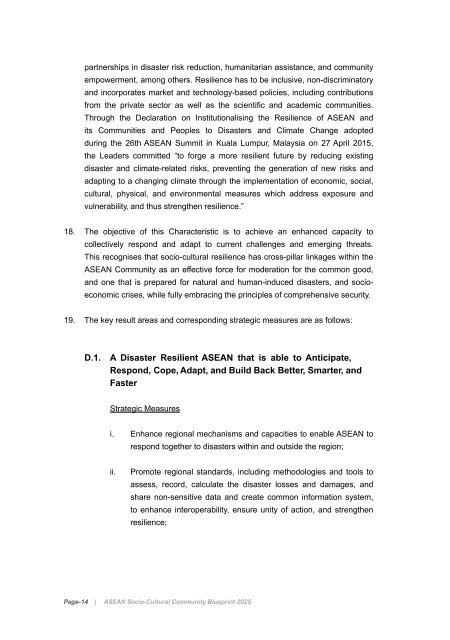ASEAN
2felxVz
2felxVz
Create successful ePaper yourself
Turn your PDF publications into a flip-book with our unique Google optimized e-Paper software.
partnerships in disaster risk reduction, humanitarian assistance, and community<br />
empowerment, among others. Resilience has to be inclusive, non-discriminatory<br />
and incorporates market and technology-based policies, including contributions<br />
from the private sector as well as the scientific and academic communities.<br />
Through the Declaration on Institutionalising the Resilience of <strong>ASEAN</strong> and<br />
its Communities and Peoples to Disasters and Climate Change adopted<br />
during the 26th <strong>ASEAN</strong> Summit in Kuala Lumpur, Malaysia on 27 April 2015,<br />
the Leaders committed “to forge a more resilient future by reducing existing<br />
disaster and climate-related risks, preventing the generation of new risks and<br />
adapting to a changing climate through the implementation of economic, social,<br />
cultural, physical, and environmental measures which address exposure and<br />
vulnerability, and thus strengthen resilience.”<br />
18. The objective of this Characteristic is to achieve an enhanced capacity to<br />
collectively respond and adapt to current challenges and emerging threats.<br />
This recognises that socio-cultural resilience has cross-pillar linkages within the<br />
<strong>ASEAN</strong> Community as an effective force for moderation for the common good,<br />
and one that is prepared for natural and human-induced disasters, and socioeconomic<br />
crises, while fully embracing the principles of comprehensive security.<br />
19. The key result areas and corresponding strategic measures are as follows:<br />
D.1. A Disaster Resilient <strong>ASEAN</strong> that is able to Anticipate,<br />
Respond, Cope, Adapt, and Build Back Better, Smarter, and<br />
Faster<br />
Strategic Measures<br />
i. Enhance regional mechanisms and capacities to enable <strong>ASEAN</strong> to<br />
respond together to disasters within and outside the region;<br />
ii.<br />
Promote regional standards, including methodologies and tools to<br />
assess, record, calculate the disaster losses and damages, and<br />
share non-sensitive data and create common information system,<br />
to enhance interoperability, ensure unity of action, and strengthen<br />
resilience;<br />
Page-14 | <strong>ASEAN</strong> Socio-Cultural Community Blueprint 2025


